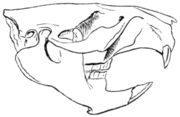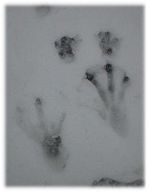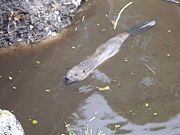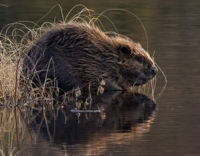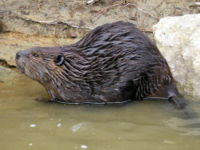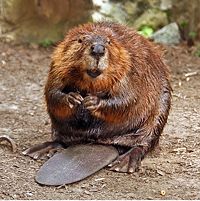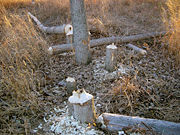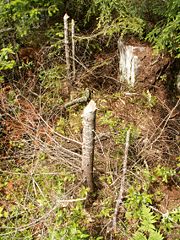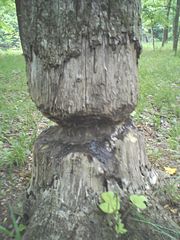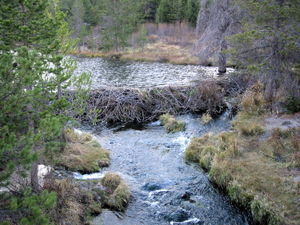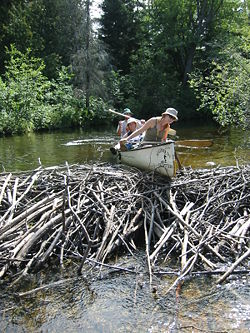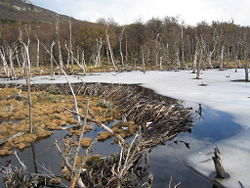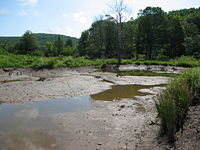Beaver
2008/9 Schools Wikipedia Selection. Related subjects: Mammals
| Beavers Fossil range: Late Miocene – Recent |
||||||||||||
|---|---|---|---|---|---|---|---|---|---|---|---|---|
 American Beaver
|
||||||||||||
| Scientific classification | ||||||||||||
|
||||||||||||
| Species | ||||||||||||
|
C. canadensis |
Beavers are semi-aquatic rodents native to North America and Europe. They are the only extant members of the family Castoridae, which contains a single genus, Castor. Genetic research has shown the European and North American beaver populations to be distinct species and that hybridization is unlikely.
General
Beavers are best known for their natural trait of building dams in rivers and streams, and building their homes (known as beaver lodges) in the resulting pond. They are the second-largest rodent in the world (after the capybara).
They are also known for their "danger signal": when startled or frightened, a swimming beaver will rapidly dive while forcefully slapping the water with its broad tail. This creates a loud 'slap', audible over large distances above and below water. This noise serves as a warning to other beavers in the area. Once a beaver has made this danger signal, all nearby beavers will dive and may not reemerge for some time. Although this happens rarely, a frightened beaver may attack a human.
Fossil remains of beavers are found in the peat and other superficial deposits of England and the continent of Europe; while in the Pleistocene formations of England and Siberia occur remains of a giant extinct beaver, Trogontherium cuvieri, representing a genus by itself.
Beavers have webbed hind-feet, and a broad, scaly tail. They have poor eyesight, but keen senses of hearing, smell, and touch.
Beavers continue to grow throughout life. Adult specimens weighing over 25 kg (55 lb) are not uncommon. Females are as large as or larger than males of the same age, which is uncommon among mammals.
Etymology
The word is descended from the Proto-Indo-European name of the animal, cf. Sanskrit babhru's, brown, the great ichneumon, Lat. fibre, Ger. Biber, Swed. bäver, Russ. bobr'; the root bhru has given "brown," and, through Romanic, "bronze" and "burnish."
Species
Beavers are closely related to squirrels (Sciuridae), agreeing in certain structural peculiarities of the lower jaw and skull. In the Sciuridae the two main bones (tibia and fibula) of the lower half of the leg are quite separate, the tail is round and hairy, and the habitats are arboreal and terrestrial. In the beavers or Castoridae these bones are in close contact at their lower ends, the tail is depressed, expanded and scaly, and their habitats are aquatic.
Both European and American beavers grow to about 2 ft (0.61 m) long (plus 10 in (250 mm) of tail). They are essentially aquatic in their habits, never travelling by land unless driven by necessity. They are crepuscular rather than nocturnal, which means they are active at dawn and dusk, and subsist chiefly on bark and twigs or the roots of water plants. They have also been known to eat grasses on the banks of rivers and streams.
European Beaver
The European Beaver (Castor fibre) was hunted almost to extinction in Europe, both for fur and for castoreum, a secretion of its scent gland believed to have medicinal properties. However, the beaver is now being re-introduced throughout Europe. Several thousand live on the Elbe, the Rhone and in parts of Scandinavia. A thriving community lives in north east Poland, and the European Beaver also returned to the Morava River banks in Slovakia and the Czech Republic. They have been reintroduced in Scotland, Bavaria, Austria, The Netherlands and Serbia ( Zasavica bog) and are spreading to new locations.
The beaver became extinct in Great Britain in the sixteenth century: Giraldus Cambrensis reported in 1188 (Itinerarium ii.iii) that it was to be found only in the Teifi in Wales and in one river in Scotland, though his observations are clearly first hand. In October 2005, six European beavers were re-introduced to Britain in Lower Mill Estate in Gloucestershire; in July 2007 a colony of four European beavers was established at Martin Mere in Lancashire, and there are plans for re-introductions in Scotland and Wales.
American Beaver
The American Beaver (Castor canadensis), also called the Canadian Beaver (which is also the name of a subspecies), or simply Beaver in North America, is native to Canada, much of the United States and parts of northern Mexico. The chief feature distinguishing C. canadensis from C. fibre is the form of the nasal bones of the skull. This species was introduced to the Argentine and Chilean Tierra del Fuego, as well as Finland, France, Poland and Russia.
The American beaver's preferred food is the water-lily ( Nuphar luteum), which bears a resemblance to a cabbage-stalk, and grows at the bottom of lakes and rivers. Beavers also gnaw the bark of birch, poplar, and willow trees; but during the summer a more varied herbage, with the addition of berries, is consumed.
These animals are often trapped for their fur. During the early 19th century, trapping eliminated this animal from large portions of its original range. However, through trap and transfer and habitat conservation it made a nearly complete recovery by the 1940s. Beaver furs were used to make clothing and top-hats. Much of the early exploration of North America was driven by the quest for this animal's fur. Native peoples and early settlers also ate this animal's meat. The current beaver population has been estimated to be 10 to 15 million; one estimate claims that there may at one time have been as many as 90 million
Giant beaver
The North American Giant beaver (Castoroides ohioensis) was one of largest rodents that ever evolved. It disappeared along with other large mammals in the Holocene extinction event, which began about 13,000 years ago.
Habitat
The habitat of the beaver is the riparian zone inclusive of stream bed. The actions of beavers for hundreds of thousands of years in the Northern Hemisphere have kept these watery systems healthy and in good repair, although a human observing all the downed trees might think that the beavers were doing just the opposite.
The beaver works as a keystone species in an ecosystem by creating wetlands that are used by many other species. Next to humans, no other extant animal appears to do more to shape its landscape.
Effect of beaver on trees
Beavers fell trees for several reasons. They fell large mature trees, usually in strategic locations, to form the basis of a dam. They fell small trees, especially young second growth trees, for food. Ponds created by beavers also kill trees by drowning.
The dam's primary role: the beaver's home
Beaver dams are created both as a protection against predators, such as coyotes, wolves and bears, and to provide easy access to food during winter. Beavers always work at night and are prolific builders, carrying mud and stones with their fore-paws and timber between their teeth. Because of this, destroying a beaver dam without removing the beavers is difficult, especially if the dam is downstream of an active lodge. Beavers can rebuild such primary dams overnight, though they may not defend secondary dams as vigorously.
Shape of dam
A dam's shape depends on the strength of the stream's current. Relatively still water encourages dams that are almost straight; while dams in stronger currents are curved, with the convexity pointing upstream. The beavers use driftwood, green willows, birch and poplars; and they mix in mud and stones in ways that contribute to the dam's strength.
Beavers have been known to build very large dams. The largest known was discovered by satellite imagery in Northern Alberta in 2007, approximately 2,790 ft (850 m) long , beating the previous record holder found near Three Forks, Montana, at 2,140 ft (650 m) long, 14 ft (4.3 m) high, and 23 ft (7.0 m) thick at the base. When objectionable beaver flooding occurs, modern water level control devices can be installed for a cost-effective and environmentally sound solution. Unwanted damage to trees can be prevented by wrapping chicken wire or sheet metal around the base of trees.
"In places," writes Hearne, "which have been long frequented by beavers undisturbed, their dams, by frequent repairing, become a solid bank, capable of resisting a great force both of ice and water; and as the willow, poplar and birch generally take root and shoot up, they by degrees form a kind of regular planted hedge, which I have seen in some places so tall that birds have built their nests among the branches."
Stimulus for dam-building
It is primarily prolonged exposure to the sound of water in motion that stimulates the beavers to build. However, studies involving beaver habitual activities have indicated that beavers may respond to an array of stimuli, not just the sound of running water. In two experiments Wilson (1971) and Richard (1967, 1980) demonstrate that, although beavers will pile material close to a loudspeaker emitting sounds of water running, they only do so after a considerable period of time. Additionally the beavers, when faced with a pipe allowing water to pass through their dam, eventually stopped the flow of water by plugging the pipe with mud and sticks. The beavers were observed to do this even when the pipe extended several meters upstream and near the bottom of the stream and thus produced no sound of running water. Beavers normally repair damage to the dam and build it higher as long as the sound continues. However, in times of high water, they often allow spillways in the dam to flow freely.
Disruption by dams
Beaver dams can be disruptive; the flooding can cause extensive property damage, and when the flooding occurs next to a railroad roadbed, it can cause derailments by washing-out under the tracks, or when a beaver dam bursts and the resulting flash flood overwhelms a culvert. This disruption is not limited to human geography; beavers can destroy nesting habitat for endangered species, and often destroy mature trees for which they have no use. Introduced to an area without its natural predators, as in Tierra del Fuego, beavers have flooded thousands of acres of land and are considered an unstoppable plague. One notable difference in Tierra del Fuego from most of North America is that the trees found in Tierra del Fuego do not coppice as do willows, poplars, aspens, and other North American trees. Thus the "damage" by the beavers seems more severe.
The dam's role in the stream's lifecycle
Wetland creation
If a beaver pond becomes too shallow due to the settling of sediment, or if the tree supply is depleted, beavers will abandon the site. Eventually the dam will be breached and the water will drain out. The rich thick layer of silt, branches, and dead leaves behind the old dam is the ideal habitat for wetland species. Many of them will have been on the fringes of the pond. Wetlands have significant environmental benefits.
The grazing meadow (vega and valle)
As the wetland fills and dries out, pasture species colonize it and it becomes a meadow suitable for grazing. In an area with nothing but forest down to the stream edge, this provides a valuable niche for many animals which otherwise would be excluded.
The riverine forest
Finally the meadow will be colonized by riverine trees, typically aspens, willows and such species which are favoured by the beaver. Beavers are then likely to recolonize the area, and the cycle begins again.
The dam's beneficial ecological effects
Bottom land
Each time the stream lifecycle repeats itself another layer of rich organic soil is added to the bottom of the valley. The valley slowly fills and the flat area at the bottom gets wider. Research is sparse on this topic, but it seems likely that much of the fabled bottom land in North America was created, or at least added to, by the efforts of the generations of beavers that lived there.
Flood control
A beaver dam has a certain amount of freeboard above the water level. When heavy rains occur, the pond fills up and the dam gradually releases the extra stored water. Often this is all that is necessary to reduce the height of the flood wave moving down the river, and will reduce or eliminate damage to human structures. Flood control is achieved in other ways as well. The surface of any stream intersects the surrounding water table. By raising the stream level, the gradient of the surface of the water table above the beaver dam is reduced, and water near the beaver dam flows more slowly into the stream. This further helps in reducing flood waves, and increases water flow when there is no rain. Beaver dams also smooth out water flow by increasing the area wetted by the stream. This allows more water to seep into the ground where its flow is slowed. This water eventually finds its way back to the stream. Rivers with beaver dams in their head waters have lower high water and higher low water levels.
Nutrient removal
Beaver ponds can cause the removal of nutrients from the stream flow. Farming along the banks of rivers often increases the loads of phosphates, nitrates and other nutrients, causing problems downstream when this water is extracted for drinking. Besides silt, the beaver dam collects twigs and branches from the beavers' activity and leaves, notably in the fall. The main component of this material is cellulose, a polymer of β-glucose monomers (This creates a more crystalline structure than is found in starch, which is composed of α-glucose monomers. Cellulose is a type of polysaccharide.) Many bacteria produce cellulase which can split off the glucose and use it for energy. Just as algae get their energy from sunlight, these bacteria get their energy from cellulose, and they form the base of a very similar food chain. However, a source of energy is not enough for growth. These bacterial populations face serious shortages of nitrous and phosporous compounds, and will absorb these nutrients as they pass by in the water stream. In this way, these and other nutrients are fixed into the beaver pond and the surrounding ecology, and are removed from the stream.
Pesticide and herbicide removal
Agriculture also introduces herbicides and pesticides into our streams. Bacteria are an extremely variable lot and some of these toxicants are metabolized and decomposed by the bacteria in the cellulose-rich bottom of a beaver dam.
Denitrification
Some scientists believe that the nitrate cascade, the production of far more fixed nitrogen than the natural cycles can turn back into nitrogen gas, may be as much of a problem to our ecology as carbon dioxide production. It is likely, but not proven, that beaver dams along a stream may contribute to denitrification (the conversion of nitrogen compounds back into nitrogen). In sewage plants, denitrification is achieved by passing the water through successive aerobic and anaerobic stages. Under a beaver dam, as the water seeps down into the soil, the oxygen is consumed by the fauna in the rich organic layer. At some point all the oxygen is used up and the soil becomes anaerobic. This water eventually finds its way back into the aerobic stream and into another beaver dam. This aerobic, anaerobic cycle continues all the way down the stream and denitrification is a likely result.
Beavers and salmon
Beaver dams are a nursery for salmon. An early indication of this was seen following the 1818 agreement between the British government of Canada and the government of America allowing Americans access to the Columbia watershed. The Hudson's Bay Company, in a fit of pique sent word to its trappers to extirpate the fur bearing animals in the area. The beaver was the first to go. Salmon runs fell precipitously in the following years even though, at that time, none of the factors were extant that we associate with the decline of salmon runs.
The functions of beaver dams in increasing salmon runs are many. They provide deep enough water for the juvenile salmon to hide from predatory wading birds. They trap nutrients in their ecology and notably the huge nutrient pulse represented by the migration of the adult salmon upstream. These nutrients help feed the juveniles after they finish their yolk. They provide quiet water so that the young salmon can put energy into growth rather than into fighting currents and larger smolt with a food reserve have a better chance when they reach the sea. And beaver dams keep the water clear which favours all the salmonoids, trout included.
Lodges
The ponds created by well-maintained dams help isolate the beavers' home, their lodge, which is also created from severed branches and mud. The beavers cover their lodges late every autumn with fresh mud which freezes when the frost sets in. The mud becomes almost as hard as stone, so that neither wolves nor wolverines can get in.
The lodge has underwater entrances to make entry nearly impossible for any other animal (however, muskrats have been seen living inside beaver lodges with the beavers who made it). A very small amount of the lodge is actually used as a living area. Contrary to popular belief, beavers actually dig out their den with an underwater entrance after they finish building the dam and lodge structure. There are typically two dens within the lodge, one for drying off after exiting the water, and another, drier one where the family actually lives.
Their houses are formed of the same materials as the dams, with little order or regularity of structure, and seldom contain more than four old, and six or eight young beavers. Sometimes some of the larger houses have one or more partitions, but these are only posts of the main building left by the builders to support the roof, for the apartments have usually no communication with each other except by water.
When the ice breaks up in spring they always leave their embankments, and rove about until a little before fall, when they return to their old habitations, and lay in their winter stock of wood. They seldom begin to repair the houses till the frost sets in, and never finish the outer coating till the cold becomes severe. When they erect a new habitation they fell the wood early in summer, but seldom begin building till towards the end of August.
Invasiveness
Beavers can create serious damage when spread outside of their natural environment, and are therefore considered in some places as pests or invasive species. For example, in the 1940s, beavers were brought to the island of Tierra Del Fuego in southern Argentina, for commercial fur production. However, the project failed and the beavers were released into the wild. Having no natural predators in their new environment, they quickly spread throughout the island, reaching a number of 100,000 individuals within just 50 years (when released into the wild there were only a few pairs). They are now considered a serious invasive species on the island, due to their massive destruction of forest trees, and efforts are being made for their eradication.
Commercial uses
Beaver pelts were used for barter by Native Americans in the 17th century to gain European goods. They were then shipped back to Great Britain and France where they were made into clothing items. Widespread hunting and trapping of beavers led to their endangerment. Eventually, the fur trade fell apart due to declining demand in Europe and the takeover of trapping grounds to support the growing agriculture sector. A small resurgence in beaver trapping has occurred in some areas where there is an over-population of beaver; trapping is only done when the fur is of value, and normally the remainder of the animal is also utilized as animal feed. The only fur in North America which surpassed the beaver's in commercial value was that of the silver morph red fox, which was said to be forty times more valuable.
Both beaver testicles and castoreum, a bitter-tasting secretion with a slightly fetid odour contained in dried preputial or vaginal follicles of male or female beaver, have been articles of trade for use in traditional medicine. Yupik (Eskimo) medicine used dried beaver testicles like willow bark to relieve pain. Beaver testicles were exported from Levant (a region centered on Israel) from the tenth to nineteenth century. Claudius Aelianus comically described beavers chewing off their testicles to preserve themselves from hunters. European beavers ( Castor fibre) were eventually hunted nearly to extinction in part for the production of castoreum, which as used as an analgesic, anti-inflammatory, and antipyretic. Castoreum was described in the 1911 British Pharmaceutical Codex for use in dysmenorrhea and hysterical conditions (i.e. pertaining to the womb), for raising blood pressure and increasing cardiac output. The activity of castoreum has been credited to the accumulation of salicin from willow trees in the beaver's diet, which is transformed to salicylic acid and has an action very similar to aspirin. Castoreum continues to be used in perfume production.
In culture
As a national emblem
The importance of the American Beaver in the development of Canada through the fur trade led to its designation as the national animal. It is depicted on the Canadian five-cent piece and was on the first postage stamp issued in the Canadian colonies in 1849 (the so-called " Three-Penny Beaver"). As a national symbol, the beaver was chosen to be the mascot of the 1976 Summer Olympics held in Montreal with the name "Amik" ("beaver" in Anishinaabemowin). The beaver is also the symbol of many units and organizations within the Canadian Forces, such as on the cap badges of the Royal 22e Régiment and the Canadian Military Engineers.
In dietary law
In the 17th century, based on a question raised by the Bishop of Quebec, the Roman Catholic Church ruled that the beaver was a fish for purposes of dietary law. Therefore, the general prohibition on the consumption of meat on Fridays during Lent does not apply to beaver meat. The legal basis for the decision probably rests with the Summa Theologica of Thomas Aquinas, which bases animal classification as much on habit as anatomy.
